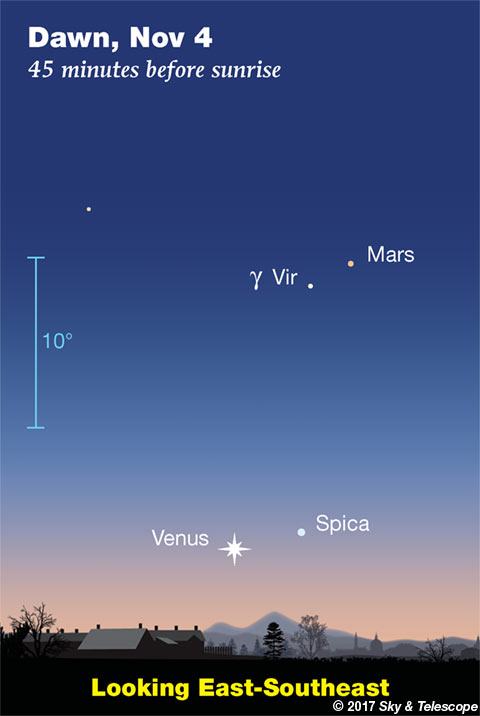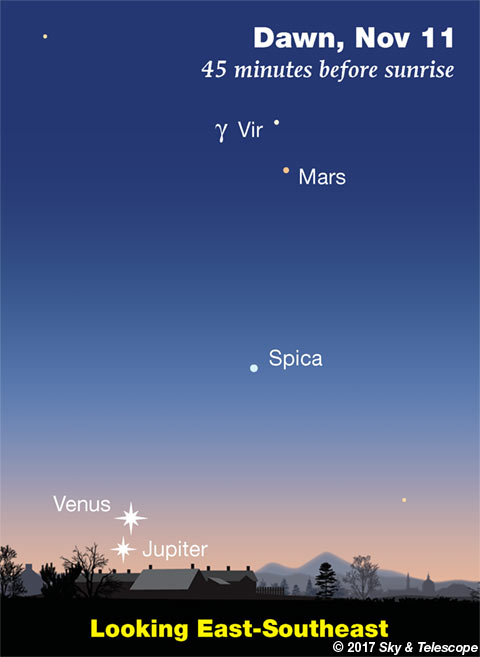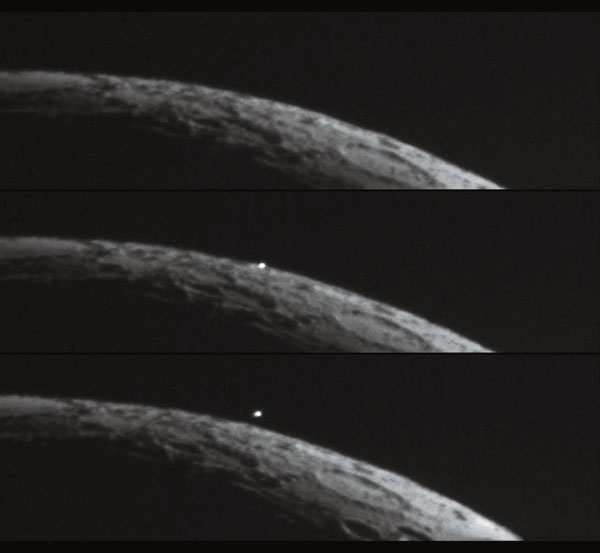

Friday, November 3
• Full Moon tonight (exactly full at 1:23 a.m.). The full Moon of November always rides very high across the sky in the middle of the night — almost as high as the full Moon of December.
Saturday, November 4
• Look lower left of the bright Moon this evening for Aldebaran. Above Aldebaran are the Pleiades, perhaps not so easy to spot in the moonlight. Binoculars help.
The bright star much farther to the left is Capella.
• Standard time returns at 2 a.m. Sunday morning for most of North America. Clocks fall back an hour.
Sunday, November 5
• The waning gibbous Moon occults Aldebaran early this evening for much of North America, and later in the night for northern Europe. The star disappears on the Moon's bright limb and reappears from behind the Moon's very thin dark sector — so for the disappearance you'll need a telescope, and for the reappearance, at least binoculars. See the November Sky & Telescope, page 51. Map and timetables.
Monday, November 6
• Around 8 p.m. this week, the Great Square of Pegasus stands in its level position very high toward the south. (It's straight overhead if you're as far south as Miami.) Its right (western) side points very far down toward Fomalhaut. Its eastern side points down less directly toward Beta Ceti, less far down.
Tuesday, November 7
• Algol should be at its minimum brightness, magnitude 3.4 instead of its usual 2.3, for a couple hours centered on 10:56 p.m. Eastern Standard Time.
Wednesday, November 8
• Now that the Moon is out of the sky in early to mid-evening, the big Silver Coin Galaxy, NGC 253 in Sculptor, awaits you. It's 7° south of 2nd-magnitude Beta Ceti (locate this star with Monday's entry above). Seven degrees is a little more than the width of a typical binocular's field of view.
The galaxy is large and diffuse, so a really dark sky is a big help. Under good sky conditions binoculars show it easily. It's "obviously elongated, distinctly brighter in the western half," writes Matt Wedel in his Binocular Highlight column (with chart) in the November Sky & Telescope, page 43.
Thursday, November 9
• The last-quarter Moon rises tonight around 10 or 11 p.m. standard time, in the east-northeast below Pollux and Castor in Gemini. Use them to tell where on the horizon to watch for it!
• Happy 83rd birthday, Carl Sagan (November 9, 1934 – December 20, 1996). If only.

Friday, November 10
• Plan for this now: In broad daylight on Saturday morning the Moon, just past last quarter, occults Regulus for much of North America. You'll need a telescope and very clear air. The star disappears on the Moon's bright limb and reappears from behind the dark limb. See the November Sky & Telescope, page 51. Map and timetables.
• Algol should be at its minimum brightness, magnitude 3.4 instead of its usual 2.3, for a couple hours centered on 7:45 p.m. Eastern Standard Time.
Saturday, November 11
• Vega is the brightest star in the west in early evening. Its little constellation Lyra extends to the left. Somewhat farther left, by about a fist and a half at arm's length from Vega, is 3rd-magnitude Albireo, the beak of Cygnus. This is one of the finest and most colorful double stars for small telescopes.
________________________
Want to become a better astronomer? Learn your way around the constellations! They're the key to locating everything fainter and deeper to hunt with binoculars or a telescope.
This is an outdoor nature hobby. For an easy-to-use constellation guide covering the whole evening sky, use the big monthly map in the center of each issue of Sky & Telescope, the essential guide to astronomy.

Once you get a telescope, to put it to good use you'll need a detailed, large-scale sky atlas (set of charts). The basic standard is the Pocket Sky Atlas (in either the original or Jumbo Edition), which shows stars to magnitude 7.6.
Next up is the larger and deeper Sky Atlas 2000.0, plotting stars to magnitude 8.5; nearly three times as many. The next up, once you know your way around, is the even larger Uranometria 2000.0 (stars to magnitude 9.75). And read how to use sky charts with a telescope.
You'll also want a good deep-sky guidebook, such as Sue French's Deep-Sky Wonders collection (which includes its own charts), Sky Atlas 2000.0 Companion by Strong and Sinnott, or the bigger Night Sky Observer's Guide by Kepple and Sanner.
Can a computerized telescope replace charts? Not for beginners, I don't think, and not on mounts and tripods that are less than top-quality mechanically (meaning heavy and expensive). And as Terence Dickinson and Alan Dyer say in their Backyard Astronomer's Guide, "A full appreciation of the universe cannot come without developing the skills to find things in the sky and understanding how the sky works. This knowledge comes only by spending time under the stars with star maps in hand."
This Week's Planet Roundup
Mercury is buried deep in the afterglow of sunset.
Venus (magnitude –3.9) and Jupiter (magnitude –1.7) rise during dawn, with brighter Venus on top. Jupiter starts the week too low to see at all, but by the morning of November 11th it's just 2° below Venus. They'll be in conjunction, an unusually close 1/3° apart, on the morning of the 13th. Look for them barely above the east-northeast horizon about 45 to 30 minutes before your local sunrise time, and bring binoculars.
Mars (magnitude +1.8, in Virgo) rises around 3 or 4 a.m. standard time and is moderately high in early dawn, well to the upper right of Venus. In a telescope Mars will be just a tiny, fuzzy dot for several months to come, but next summer it will have its closest opposition since 2003.
Saturn (magnitude +0.5, in southern Ophiuchus) glows very low in the southwest at dusk.
Uranus (magnitude 5.7, in Pisces) and Neptune (magnitude 7.8, in Aquarius) are well up after dark in the southeastern side of the sky. Neptune is only 0.6° south of Lambda Aquarii. Use our finder charts online or in the October Sky & Telescope, page 50.
______________________
All descriptions that relate to your horizon — including the words up, down, right, and left — are written for the world's mid-northern latitudes. Descriptions that also depend on longitude (mainly Moon positions) are for North America.
Eastern Daylight Time (EDT) is Universal Time (UT, UTC, GMT, or Z time) minus 4 hours. Eastern Standard Time (EST) is UT minus 5 hours.
______________________
"This adventure is made possible by generations of searchers strictly adhering to a simple set of rules. Test ideas by experiments and observations. Build on those ideas that pass the test. Reject the ones that fail. Follow the evidence wherever it leads, and question everything. Accept these terms, and the cosmos is yours."
— Neil deGrasse Tyson, 2014
______________________
"Objective reality exists. Facts are often determinable. Vaccines save lives. Carbon dioxide warms the globe. Bacteria evolve to thwart antibiotics, because evolution. Science and reason are not fake news, not a political conspiracy. They are how we discover reality. Civilization's survival depends on our ability, and willingness, to use them."
— Alan MacRobert, your Sky at a Glance editor
______________________
"Facts are stubborn things."
— John Adams, 1770
 5
5








Comments
StarGazingPro
November 3, 2017 at 12:34 pm
My neighbor's son, Alex (6 yrs old), is just starting to get curious about astronomy, as he is always fascinated with the 10-inch Dobsonian whenever I wheel it out into my backyard. I'm trying to convince his Dad to bring him over to my house early on Nov 11th so that I can show them Mars, Venus and possibly Jupiter all in one session.
This will be a great opportunity to get Alex interested and hooked into learning more. Who knows, he may turn into a future scientist!
You must be logged in to post a comment.
robertnobleallen
November 3, 2017 at 7:26 pm
..hope it turns out well for yourself and the young lad..
You must be logged in to post a comment.
mary beth
November 4, 2017 at 12:25 am
Wish I'd had a neighbor like that!
You must be logged in to post a comment.
stanleypatkan
November 3, 2017 at 8:13 pm
I really appreciate the star map I can print.
You must be logged in to post a comment.
November 8, 2017 at 4:58 am
On the morning 7th nov Jupiter season started. 35 min before sunrise mighty Jove was seen with my binoculars 2° above the horizon.
You must be logged in to post a comment.
You must be logged in to post a comment.